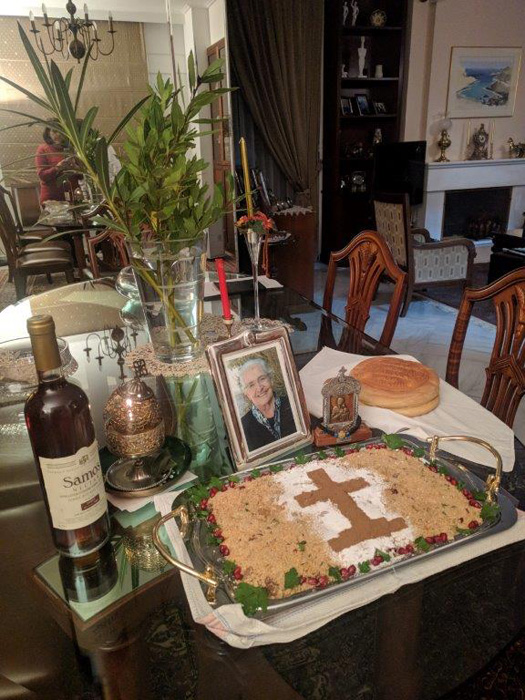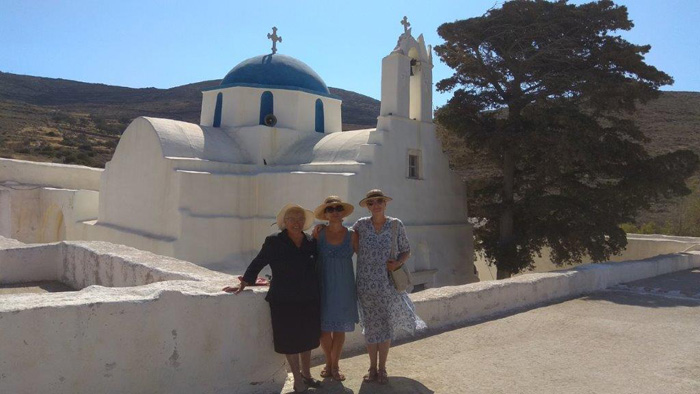It is six
months since my godmother, Presvytera Irini Cherouveim, died. Thus the
fourth memorial service for her was due recently, following the 9-day,
40-day and quarter-year memorials, to be followed by memorials at the
ninth month and the whole year. She died unexpectedly just after her 79th
birthday – still young for a Parian – having just cooked a meal
for her two daughters, sons-in-law and five grandchildren, cleaned up
the kitchen with her daughters. She lay down for an afternoon nap and
was gone.
The whole family was on Paros for the mnimósino, the memorial service,
and not in Athens, even though the school year was about to begin (with
masks for everyone in the schools: teachers, pupils, administrators: everyone).
The Papadheiá was known to all on Paros and Antíparos as
the wife of Papapétros, former priest of Paros's Ekatontapyliani
and of the Taxiarchi in the centre of town, who had died ten years before.
Since his death, she wanted only to join him, she told me, and now she
has, in a single grave, and also wherever we all go to when we leave this
life.
As their godchild I was invited to help the evening before the service
in making the kólyva. This wheaten dish is essential to every memorial
service, is present during the service along with a photograph of the
deceased, and is distributed to all in little cups after the service.
Nowadays all of the bakers and pâtissiers make it to order, but
in this home it was made in the traditional way by the family women, in
this case the two daughters, their godmother, myself and a close family
friend. First a kilo and a half of whole wheat seeds were boiled until
tender, thoroughly drained, then spread out to dry on sheets and towels
atop tables all over the house. When I arrived around 21.00, the seeds
were dry and ready. In pairs we picked up the cloths and gently shook
the seeds out into a large bowl on the kitchen table. We then placed all
of the other ingredients on the table: white sugar, cinnamon powder, very
finely ground sesame seed meal, raisins, almonds (from my husband's and
my trees), pomegranate seeds, and parsley, cut very carefully into about
50 perfect leaves. Each ingredient was inspected for perfection: no flaws,
no spots, no wilting, no dust. A candle was lit before the bowl, and incense
in a little burner, and everything stood on the table where we worked
along with a photo of the Papadheiá.

Kolyva with photo of the Papadheia and accoutrements
One by one we added each ingredient: the sugar, cinnamon, raisins, almonds and pomegranate seeds, filling our thoroughly washed, clean hands cupped full with each, then pouring it over the wheat seeds in the form of a cross while praying aloud, 'Lord God, rest the soul of your servant Presvytera Irini', which was repeated three times. After each prayer (spoken in silence? Well, hardly!) in between each addition, we mixed the ingredient with the wheat. This procedure was done very carefully and took a long time, each step carefully observed and perfect, all of the women working together – and all talking at once, giving orders and instructions, making suggestions, checking that each leaf, raisin, nut or seed be perfect, gossiping. (The men were banned to the front porch for the duration.) As we chattered and prayed and worked together, I thought about how often over the past 10,000 years little coveys of women had gathered together, chattering yet punctilious and reverent, to perform their magic and make something wonderful - and about how much magic my noná had made with her own hands in that very same kitchen.
When the mixture was complete, we removed about a third of it and laid it on a large platter forming a sort of loaf of the whole. This was the part of the kolyva that would be brought to the church for the memorial service. (The rest was set aside to be put in the little cups for everyone at the service.) The next step was to spread the finely ground sesame seed meal over the top of the loaf-like kolyva, cover it with non-absorbent wax paper, pat it down firmly into place, and remove the paper. Then the whole was covered with a generous layer of granulated white sugar, making a large, white, oval-shaped mound. (The sesame seed meal prevents the sugar from seeping down into the wheat seed mixture and making it soggy.)
The final step was the decoration. The pattern is decided by each family individually. In our case we did not use the silver beads popular these days, but made a rim around the white mound of kolyva with perfect small parsley leaves alternating with dark red glowing pomegranate seeds to form a pretty, brightly coloured trim around the white sugar loaf. The final touch was a cross of cinnamon sugar, made by placing a cut-out paper pattern over the center of the mound, gently but firmly holding it in place (many hands, much care! repeated admonitions to be careful!), and pouring cinnamon sugar into it. Then finally came the dramatic moment of removing the cross-shaped form quickly, without sloppiness or damage to the design. Finished.
The next morning the kolyva stood on a small table in the church with a photo of my godmother and a little flower. Worshippers laid candles beside it as they entered, to be lit later in her memory.
The service is well known to all and contains the notable text: 'may her memory be eternal' – addressed not to ourselves, who will pass, too, in our time – but to God and his angels. May they never forget her, or us either! When the service was over, everyone wished everyone else, 'may her prayers be with you', as she is now nearer God than we are, and goodness knows we could use her help! And all left the church with a little cup of kolyva, to savor and enjoy at our leisure, along with the memory of an exemplary person.
That day the priest gave a particularly fine sermon on the importance of the presvytéra, wife of the presvýteros (priest), or, in everyday speech, the papadheiá, wife of the papás. She is unique, he said, in sharing the title of her husband, and is thus accorded great respect. The tradition goes back to Abraham and Sarah, who together welcomed to their table three strangers who turned out to be angels. It was Sarah who provided hospitality to the three, and that is the role of the papadheiá, he said: to be the
Certainly this is what my noná did. Her door was always open – both her house door and her refrigerator door! – and no one ever left her house without at least a cup of coffee and a biscuit and very often with a complete meal, with course after course, while her husband the priest saw that the guest got whatever it was he or she had come for – comfort, consolation, advice, kindness, or his wife's food. I have seen her produce on the spot, for an important surprise visitor on Good Friday, a fasting feast of shrimps, octopus, salad, olives, nuts, fruit, boiled and fresh vegetables of every sort, and sugar sweets – all without oil, butter, eggs, meat, fish or cheese, which are forbidden during the fast. She made this visitor feel that he was at home and could rest at her table, and I saw myself how he relaxed after a very trying time during the weeks of the fast and Easter week, and how grateful he was.
Truly, she was exemplary of her kind. Her prayers be with us all!

The author (right) with the Papadheia and her daughter Lenia.
More than 150 people attended the memorial service, most gathered outside
in the street, since the church of the Taxiarchi is small to begin with
and with Covid distancing it seats only about 30 people. After the service,
more than 90 people came to the family house for cookies and coffee made
to order: bitter, medium or very sweet, served by the papadheiá's
children and grandchildren in pretty little china cups. No plastic or
cardboard substitutes in this family, in this house!
All left the house feeling the blessing of the kolyva, the respect and
honor due to a beloved and extraordinary person, the ancient memorial
ritual repeated and the more meaningful for the years and the repetition.
